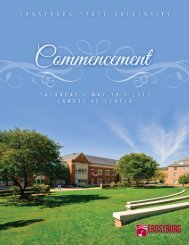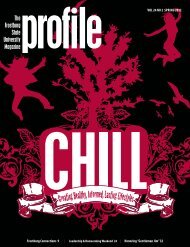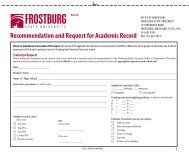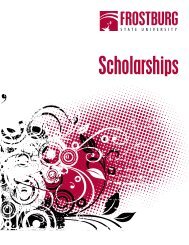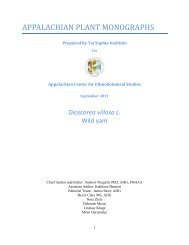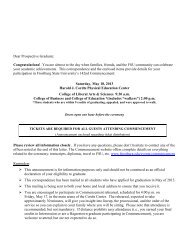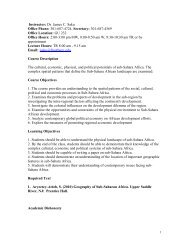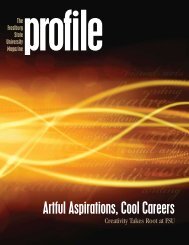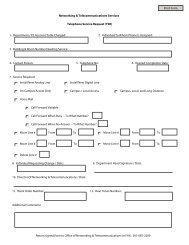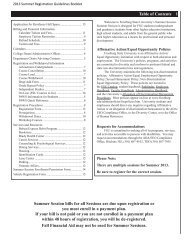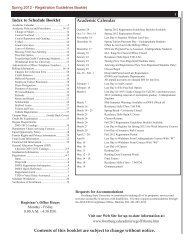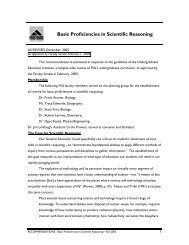Fall 2009 - Frostburg State University
Fall 2009 - Frostburg State University
Fall 2009 - Frostburg State University
You also want an ePaper? Increase the reach of your titles
YUMPU automatically turns print PDFs into web optimized ePapers that Google loves.
Arnold flew on his<br />
first space shuttle<br />
mission in March,<br />
nearly 13 days in<br />
space in which he<br />
and his fellow crew members<br />
delivered solar panels and the<br />
truss assembly that holds them.<br />
These final pieces were required<br />
to fully power the International<br />
Space Station.<br />
After five years of training,<br />
education, practice and simulations,<br />
there was little that happened<br />
on Space Shuttle Discovery<br />
or on the International Space<br />
Station that Arnold hadn’t experienced<br />
or studied in one way or<br />
another, until …<br />
“Looking out the window,<br />
there’s no way to prepare yourself<br />
for that,” Arnold said.<br />
Practically every move the<br />
astronauts made during the STS-<br />
119 mission had been rehearsed<br />
over and over on the ground.<br />
Even the sensation of walking<br />
in space had been reproduced in<br />
NASA’s buoyancy lab, a big pool<br />
in Houston with a submerged<br />
mock-up of the Space Station.<br />
With the intensive training<br />
and packed work schedule on<br />
the station, at one point Arnold<br />
thought, “‘Boy, I could really be<br />
in a simulator back in Houston<br />
right now,’ except that you might<br />
be hanging from the ceiling or<br />
your tools are floating by,” he<br />
said. He decided it was important<br />
to glance out the window from<br />
time to time to remind himself<br />
that he wasn’t in Texas anymore.<br />
Arnold reported that life in<br />
space was a mixture of intense<br />
duties, discoveries and surreal<br />
moments. Something seemingly<br />
simple like learning to sleep in<br />
space was an interesting chal-<br />
All photos courtesy of NASA<br />
lenge, with no gravity to hold<br />
him onto a mattress or a pillow,<br />
which is what his body had come<br />
to expect.<br />
“I used some bungee cords to<br />
hold myself to the wall or the<br />
floor and some Velcro straps to<br />
keep the pillow at my head,” he<br />
said. “John Phillips, who had<br />
been on the space station before<br />
for months, just used a sleeping<br />
bag on a hook. … It takes getting<br />
used to.”<br />
Arnold may have<br />
been more than<br />
200 miles straight<br />
up, but he wasn’t<br />
out of touch. He<br />
was able to carve a couple of<br />
opportunities out of the busy<br />
mission schedule to e-mail a few<br />
friends – including some fellow<br />
FSU alums – and to call his<br />
family using the ISS’s Voice Over<br />
Internet Protocol (VOIP) System,<br />
which was set up for the space<br />
station crew members who spend<br />
months away from earth. He and<br />
the other astronauts also got to<br />
speak to President Obama, who<br />
was joined by a group of school<br />
children at the White House for a<br />
video conference.<br />
Each morning, the shuttle crew<br />
is awakened by Mission Control<br />
with a different song specific to<br />
one of the astronauts. Arnold’s<br />
songs, chosen by his wife and<br />
two daughters, were “Bright Side<br />
of the Road” by Van Morrison<br />
and “In a Little While,” which<br />
was performed by friends of his,<br />
a Houston-area group called<br />
Pilgrim and Trout. He enjoyed<br />
expanding the group’s reach to an<br />
astronomical level.<br />
The only low time was during<br />
several flight delays, which postponed<br />
takeoff by about a month.<br />
Each time a scheduled takeoff<br />
neared, all the astronauts had to<br />
go into quarantine for four to<br />
five days before launch, as well<br />
as adjust their sleep schedules.<br />
The first launch was scheduled<br />
for early morning, so they had<br />
to adjust their internal clocks to<br />
wake up around 10 p.m. That<br />
process was repeated several times<br />
– with different wake-up times –<br />
before the actual launch.<br />
“That’s hard on your family,”<br />
Arnold said. “But once you get<br />
into space, you forget all that.”<br />
The main goal of STS-<br />
119 was to deliver and<br />
install the final pair<br />
of power-generation<br />
solar array wings and the truss<br />
that would hold them to the<br />
station. Arnold performed two<br />
of the three spacewalks on the<br />
mission, where the view was even<br />
better than through the Space<br />
Station window.<br />
“On the first space walk, we<br />
came out at night and saw the<br />
sun come up in the broad panorama<br />
through my visor,” he<br />
said. “You’re 200-some miles up,<br />
traveling 17,000 miles per hour.”<br />
That perspective took some getting<br />
used to.<br />
The first six-hour session, with<br />
astronaut Steve Swanson, helped<br />
to install the 16-ton, 45-footlong<br />
truss and the two solar<br />
arrays – stretching 240 feet tip to<br />
tip – onto the orbital scientific<br />
complex. They guided the other<br />
astronauts who were maneuvering<br />
the truss with the station’s robotic<br />
Ricky Arnold ’85, left, partially obscured by the International Space Station’s robotic Canadarm2, participates in his second spacewalk during the STS-119 mission of Space Shuttle Discovery, a 13-day<br />
mission that lasted from March 15 to 28. Earth can be seen behind the station, more than 200 miles below.<br />
arm, then they bolted the truss<br />
onto the station and hooked up<br />
everything. The arrays doubled<br />
the electric power available to the<br />
station’s science laboratories.<br />
On his second spacewalk with<br />
fellow educator astronaut Joe<br />
Acaba, the third for the mission,<br />
Arnold was the leader. “It was a<br />
pretty good deal for me on my<br />
first spaceflight and only my second<br />
spacewalk,” he said.<br />
That six-and-a-half-hour<br />
spacewalk involved moving and<br />
maintaining equipment, as well as<br />
making a second attempt to free a<br />
mechanism that had gotten stuck<br />
while being deployed on the second<br />
of the three spacewalks.<br />
“It was not going anywhere,”<br />
he said. NASA engineers subsequently<br />
developed a tool to deal<br />
with the problem, which was<br />
fixed on a later shuttle mission,<br />
he said.<br />
The first spacewalk was<br />
so packed with duties<br />
that Arnold didn’t<br />
have much time to<br />
reflect, or even look around, but<br />
the second outing provided that<br />
opportunity, and one of the highlights<br />
of his flight.<br />
“Joe was getting back in<br />
first. We were going over<br />
Newfoundland and Labrador<br />
and the sun was just going down.<br />
While I was waiting for him, I<br />
was able to look around, watch<br />
the sunset over the snow and ice,”<br />
he said. “It was pretty amazing.”<br />
When they undocked from<br />
ISS, they had enough fuel to<br />
spare an opportunity to review<br />
their work and take scores of<br />
photos as the shuttle circled the<br />
station at a distance of 400 feet.<br />
There’s a practical purpose –<br />
the space station is bombarded<br />
constantly by tiny fragments of<br />
debris. The highly detailed photos<br />
are examined by NASA engineers<br />
looking for damage to the station.<br />
“The bonus for the crew is we<br />
can take the pretty pictures that<br />
everyone else likes to look at,”<br />
Arnold said of this mission highlight.<br />
“When you can see your<br />
work, it’s pretty spectacular.”<br />
Speaking with an undercurrent<br />
of wonder — as a boy, he followed<br />
the Apollo missions, and<br />
as a man, he realized a lifelong<br />
dream — Arnold said he has been<br />
so busy since the mission that he<br />
hasn’t really had time to sit and<br />
reflect on his experience. After all,<br />
he traveled more than 5 million<br />
miles in the course of 12 days,<br />
19 hours, 29 minutes and 33<br />
seconds.<br />
“I just had to capture some<br />
mental snapshots to think about<br />
later.” <br />
10 PROFILE<br />
FALL<strong>2009</strong> 11




